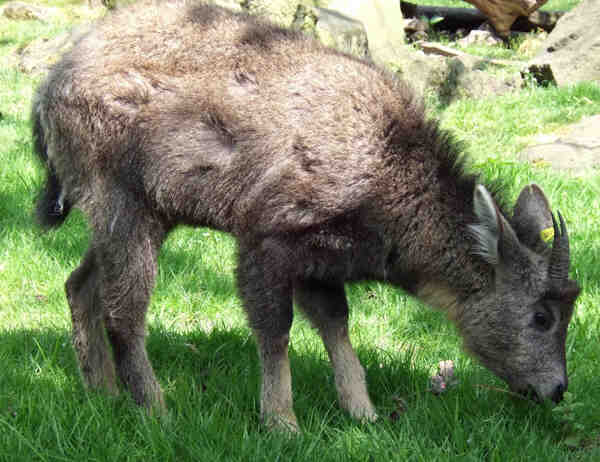Naemorhedus caudatus
IUCN
LCBasic Information
Scientific classification
- name:Naemorhedus caudatus
- Scientific Name:Naemorhedus caudatus,Long-Tailed Goral,Naemorhedus caudatus caudatusMilne-Edwards,North China Mountain Antelope
- Outline:Ungulata
- Family:Artiodactyla Bovidae Caprinae Goral
Vital signs
- length:106-120cm
- Weight:32-42kg
- lifetime:15-17years
Feature
The protagonist of Flight of the Antelope
Distribution and Habitat
Distributed in China, the Democratic People's Republic of Korea, South Korea and Russia.
The distribution range includes mountain ranges in East and North Asia, including eastern Russia, northeastern China and South Korea. In Russia, it is distributed in the southern part of the Sikhote-Alin and Bureya mountains and many major rivers (e.g., Kol, Kafen, Chuken and Sukpay). In China, it is mainly distributed in the northeastern region, especially the Lesser Khingan Mountains, and the Changbai Mountains near the border with North Korea. In South Korea, although it is not widely distributed, it is believed to be found in Hamgong and Taebaek Mountains.
The long-tailed goral prefers steep mountainous areas as its habitat and is usually found in rocky areas in rocky and evergreen deciduous forests. Sometimes they can also be found on exposed grassy ridges. They forage on grassy ridges and usually hide in forests or rock crevices, often taking shelter under rocks.
Appearance
The long-tailed goral has a head and body length of 1060-1200 mm, a shoulder height of 690-750 mm, a tail length of 130-160 mm, an ear length of 130-170 mm, a hind foot length of 270-320 mm, and a weight of 32-42 kg. It is gray with a light throat spot, and its coat is mainly gray-brown without black coverage. It is much smaller than the serow, has a lighter body color, and has no mane, although it also has an unobvious dark back stripe. The limbs are lighter in color than the body, but not as contrasting as the Chinese goral. It differs from the goral in that it has a tuft of hair on its tail and the black stripes on the outside of its forelimbs reach below the wrist instead of just to the middle of the forelimbs. There are rings at the base of the backward-curving horns, but they are much slender than those of the serow. The horns are short (usually 127-178 mm, but can be up to 235 mm), there are inconspicuous preorbital glands, the undercoat is thicker and softer than that of the se
Details
Long-Tailed Goral, no subspecies.

Long-Tailed Gorals spend most of the year in small groups of 12 or less. Females, young gorals and sub-adult gorals form this group and move together, while older males usually live alone. They move in steep rocky areas and migrate up to 2 kilometers. In summer, the gorals that live in Russia live no closer than 1 km from steep cliffs. In winter, when they are not feeding, they can be found hiding in rock overhangs and caves. Gorals avoid walking in heavy snow, and if the snow is more than 35 cm deep, they will leave belly marks in the snow. They are active during the day or dusk, most active in the early morning and evening, resting at noon, and more active on cloudy days. They often drink water from streams.
In emergency situations, gorals communicate with each other through hoarse alarm calls. They use hoof stamping sounds to threaten predators and warn other carnivores in the area. During the mating season, males attract females with the sounds of "zer...zer" or "ze-ze-ze". When females approach and are ready to encourage males, they make whistling calls. The nose-to-genital contact required during the mating season is a form of communication that produces chemical secretions. It makes a hissing snorting sound when frightened.
During the mating season, males of the Long-tailed Goral occupy an area of 22-25 hectares. During the estrus period, males follow females closely to contact their genitals with noses to determine whether the female is in estrus. Females that are not in estrus will leave the area, while females in estrus will approach males and indicate that they are in estrus by raising their tails. Mating occurs in early winter. The estrus period is about 20-30 hours, the gestation period is 6-8 months, and the gestation period is about 180 days. The young are usually born between April and May. On average, one young can be born per litter, but in rare cases, twins can also appear. The young are weaned at 8 months old, but the young still live with their mother for about a year. Sexual maturity is reached in the second to third year.
In some areas, the natural enemies of the long-tailed goral are carnivores, including snow leopards, tigers, and wolves. People also hunt and poach them for their fur, meat, and parts that can be used in medicine, so they are also considered predators. They will not flee until a predator almost attacks them. When the long-tailed gorals flee from predators, they leap up the hill in an erratic manner, including long jumps, and this straight-up jump confuses predators.
Listed in the IUCN Red List of Threatened Species in 2016 ver 3.1 - Least Concern (LC).
Listed in the second level of the China National Key Protected Wildlife List.
Protect wild animals and stop eating game.
Maintaining ecological balance is everyone's responsibility!








